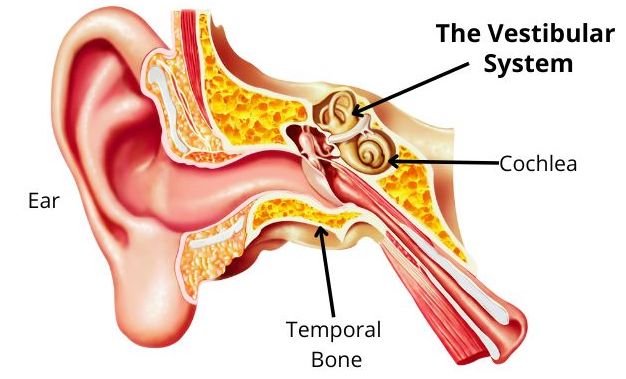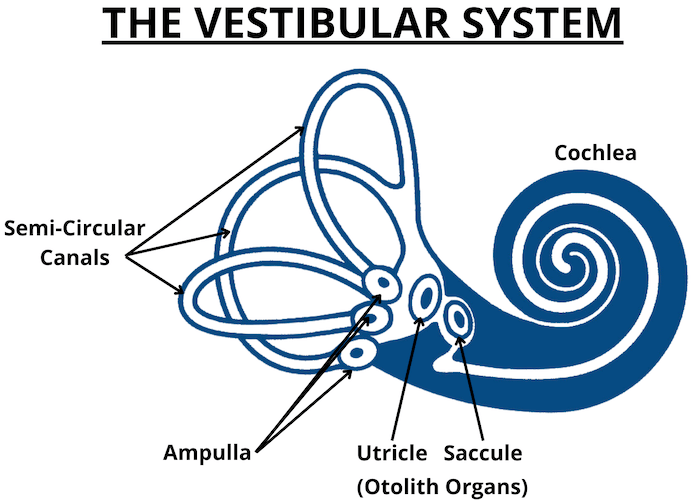Vestibular Exercises: Exercises For Dizziness, Vertigo and Motion Sensitivity
EASING VESTIBULAR SYMPTOMS
As we age, it is not uncommon to experience symptoms of dizziness (lightheadedness and unsteadiness), vertigo (a sensation of spinning or whirling), motion sensitivity (motion sickness) and balance problems. These are all vestibular symptoms and can significantly impact daily activities and quality of life.
Fortunately, there are proven strategies that can reduce symptoms of vestibular issues.
In this article, we will look at the vestibular system so you can better understand what may be happening when you're experiencing these symptoms. We will also look at what can improve symptoms, including exercises and more.
NOTE BEFORE: It's important to remember that not all dizziness is caused by vestibular issues. Dizziness can have various causes, including neurological, cardiovascular, or metabolic conditions, medication side effects, dehydration, anxiety, and more. Therefore, please ensure you see your doctor or health care professional if you experience dizziness, especially if it's persistent or severe, to determine the underlying cause and receive appropriate treatment.
WHAT WE WILL BE COVERING IN THIS ARTICLE:
WHAT IS THE VESTIBULAR SYSTEM AND WHAT DOES IT DO?
The vestibular system is a sensory system of our body, which is predominantly situated in the inner ear, safe and protected inside the temporal bone. It sits adjacent to our cochlea, our organ of hearing.
Diagram: The Vestibular System
It contains three canals, known as the semicircular canals, and two organs, the utricle and saccule, which are known as the otolith organs.
The semicircular canals are positioned at right angles to each other, allowing them to detect rotational head movements. They are filled with fluid (known as endolymph). When the head moves, this fluid flows into an area called the ampulla.
Diagram: A closer look at the Vestibular System
In the ampulla, the movement of the endolymph causes the movement of hair cells, which sends signals or information about the head movement to the brain.
The otolith organs (utricle and saccule) also detect movement. They are responsible for detecting linear acceleration of the head (which are changes in speed or direction in a straight line) and changes in head position with respect to gravity, such as when the head moves forward or backward or when the head is tilted up or down.
More specifically, the utricle is sensitive to horizontal head movement, e.g., moving forward or backward in a car. The saccule is sensitive to vertical head movement - moving up and down.
The otolith organs contain hair cells that are covered with tiny crystals of calcium carbonate called otoconia (or otoliths). When the head moves, the otoconia shift, and the hair cells' movement generates nerve impulses transmitted to the brain.
Together, the semicircular canals and the two otolith organs provide the brain with information about the position, movement, and orientation of the head and body, allowing us to maintain balance, coordinate our movements and provide us with a sense of where our body is in relation to the space around us (spatial orientation).
However, there may be times the vestibular system may not function as it should, leading to symptoms including:
Dizziness or vertigo
Imbalance, lightheaded or unsteadiness
Motion sensitivity or motion sickness
Nausea or vomiting
Sensitivity to light or sound
Tinnitus or ringing in the ears
The feeling of fullness in the ears
Imbalance or unsteadiness
Headaches or migraines.
VERTIGO IN SENIORS: DIZZINESS VS VERTIGO
A symptom of vestibular issues, which can occur among older adults, is vertigo.
Vertigo is a specific type of dizziness characterized by a spinning or whirling sensation.
Dizziness, on the other hand, is a more general term that can refer to a range of symptoms, including lightheadedness, unsteadiness, and feeling faint.
The most common cause of vertigo is Benign Paroxysmal Positional Vertigo (BPPV).
BPPV is a condition where the otoconia (the calcium carbonate crystals discussed above), typically embedded in a gel membrane, become displaced from the utricle and move into one or more of the fluid-filled semicircular canals where they shouldn't be.
How Vertigo Occurs.
This can cause the canals to become overly sensitive to head movements, leading to feelings of dizziness or spinning when the head is moved in certain positions.
BPPV is typically a self-limiting condition that resolves on its own within a few weeks to months, although it can recur in some individuals.
Treatment options for BPPV may include a series of specific head and body movements, known as canalith repositioning procedures (EG. Epley Maneuver) or vestibular rehabilitation exercises, to help move the displaced otoconia out of the semicircular canals and restore normal vestibular function. Medications and surgery are generally not recommended for BPPV.
POSTURAL HYPOTENSION: ANOTHER TYPE OF DIZZINESS
Another type of dizziness that is not uncommon when one gets older is postural hypotension.
Postural hypotension is dizziness or lightheadedness when going from lying or sitting to a standing position. Postural hypotension is caused by a drop in blood pressure.
With postural hypotension, vestibular exercises are not typically used as a treatment.
Postural hypotension is usually managed by addressing underlying medical conditions contributing to the problem, adjusting medications, and making lifestyle modifications such as drinking plenty of fluids, avoiding alcohol, and standing up slowly and standing to a walking aid if required.
However, vestibular exercises can help improve balance and reduce the risk of falls that may occur as a result of postural hypotension.
If you experience dizziness when going from a lying or seated to a standing position, let your doctor know.
Vestibular Exercises for Seniors (EXERCISES FOR DIZZINESS, VERTIGO & MOTION SENSITIVITY)
Vestibular exercises can improve balance, reduce dizziness and vertigo, and increase confidence in daily activities. These exercises can also help prevent falls and promote physical and mental health.
Studies have shown that vestibular exercises can improve the vestibular system's function and reduce symptoms of dizziness and vertigo. These exercises can also help improve postural stability and reduce the risk of falls. [1, 2, 3, 4]
A successful vestibular rehabilitation program should contain exercises of the eyes, the neck and the rest of the body.
Types of vestibular exercises that are commonly used in vestibular rehabilitation include:
Eye and Head Exercises: These exercises may involve moving the head in different directions while focusing on a stationary object or tracking a moving object with the head and eyes.
Gaze Stabilisation Exercises: These exercises involve fixing your gaze on a stationary object while your head is moving. This helps train your brain to interpret signals from your vestibular system better.
Balance Exercises: These exercises help improve your overall balance and reduce your risk of falls. Examples include standing on one leg, walking heel-to-toe, and standing on an unstable surface.
Habituation Exercises: These exercises involve exposing yourself to movements or situations that typically trigger your symptoms in a safe and controlled environment. Over time, your brain may learn to tolerate these movements or situations without causing symptoms.
Canalith Repositioning Manoeuvres: These manoeuvres involve moving your head and body in specific ways to help reposition tiny crystals in your inner ear that may have become dislodged, leading to vertigo.
Brandt-Daroff Exercises: These exercises involve repeatedly sitting up and lying down in a specific way to help desensitise your brain to movements that may trigger vertigo.
It's important to note that the prescribed exercises will depend on symptoms and diagnosis and should be guided by a healthcare professional trained in vestibular rehabilitation.
And it is essential to take precautions when performing vestibular exercises to reduce the risk of injury, including measures in place to prevent falls.
Always start with gentle exercises and gradually increase the intensity as you become more comfortable. If you experience any pain or discomfort, stop the exercise immediately.
Incorporate vestibular exercises into your daily routine to get the most benefit. Start with a few minutes of exercise daily and gradually increase the duration and intensity.
BEGINNER VESTIBULAR EXERCISES (VIDEO)
Join me for these slower-paced vestibular exercises that are perfect for seniors.
These vestibular rehabilitation exercises can be used to relieve symptoms associated with vestibular dysfunction, that being dizziness, vertigo and motion sensitivity.
Always make sure you see your doctor or Vestibular Physiotherapist before undertaking these exercises.
Beginner Vestibular Exercises
INTERMEDIATE VESTIBULAR EXERCISES (VIDEO)
Intermediate Vestibular Exercises
Other Tips for Preventing Dizziness and Vertigo in Seniors
In addition to vestibular exercises, there are other steps you can take to prevent dizziness and vertigo. These include:
Reducing stress can help prevent dizziness and vertigo by reducing tension in the body and promoting relaxation.
Practising relaxation techniques: Stress and anxiety can worsen dizziness and vertigo. Practising relaxation techniques such as deep breathing, meditation, or yoga can help reduce stress and improve symptoms.
Staying hydrated is required for good health and can help prevent dehydration, which can cause dizziness.
Eating a healthy diet rich in nutrients and low in processed foods and vegetable oils can help maintain overall health and prevent conditions that may lead to dizziness or vertigo.
Getting enough sleep is vital for overall health and can help prevent fatigue, which can contribute to dizziness and vertigo.
Improving general fitness may not directly decrease vestibular issues, but it can improve overall health and reduce the risk of certain health conditions that may contribute to vestibular problems. Additionally, regular exercise can improve balance and coordination, which may help compensate for vestibular dysfunction and reduce the risk of falls.
Avoiding alcohol, tobacco, and other stimulants can help prevent dizziness and vertigo by reducing the risk of conditions that may lead to these symptoms.
Using caution with medications: Some medications can cause dizziness as a side effect. Talk to your doctor about any medications you're taking and whether they could contribute to your symptoms.
Managing underlying conditions: Certain conditions, such as migraines and inner ear disorders, can cause dizziness and vertigo. Managing these underlying conditions through medication or other treatments can help prevent symptoms.
References
For References used in this article, click here.


